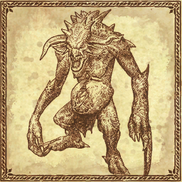No edit summary |
No edit summary |
||
| Line 27: | Line 27: | ||
** {{Endn|1b}}: pg. 60 |
** {{Endn|1b}}: pg. 60 |
||
[[es:Territorio Troll]] |
[[es:Territorio Troll]] |
||
| ⚫ | |||
[[Category:Old World]] |
[[Category:Old World]] |
||
[[Category:Regions of Kislev]] |
[[Category:Regions of Kislev]] |
||
[[Category:Troll]] |
[[Category:Troll]] |
||
| ⚫ | |||
[[Category:T]] |
[[Category:T]] |
||
Revision as of 13:16, 20 May 2020

Troll Country
The Troll Country consists of steppe slowly turning into tundra as one travels north before meeting the great mountains and the edge of the Chaos Wastes. It is some of the least-forgiving land in the Old World, and no farming is possible. There are some forests and two main ranges of hills, but for the most part, it is largely flat. It is easy to travel for days without seeing any settlements here.[1a]
The weather is harsher than in most parts of Kislev, frigid weather extending through spring and autumn. Winter can blanket several feet of snow fall over most of the area, making movement impossible. On the upside, movement is impossible for raiders as well. The Kislevites who live here spend the winter in one place, preparing for the troubles that come with the thaw. By the time the weather does break, they are generally looking forward to them.[1a][1b]
The People
The population of the Troll Country is overwhelmingly Ungol and mostly nomadic. Fixed settlements are targeted repeatedly by raiders while nomads can just move on. Out here, nationality is largely a matter of choice. Most Ungols and virtually all Gospodars regard themselves as Kislevites, but some do not, and the local boyars can do nothing about it. There are Norsemen who live in this area year round rather than simply raiding, particularly the Sarls in the north, and they are a far more serious problem.[1b]
The Ungols and Gospodars out here take hospitality even more seriously than Ungols elsewhere. Anyone is welcomed, but hardly anyone is trusted. Those who prove to be friendly over time may find that, after a year or so, they are no longer attended by heavily armed hosts at all times.[1b]
Significant Locations
As there are very few settlements in the Troll Country, most of the significant locations take different forms.[1b]
Habitat

The land of Troll Country is very harsh. The climate is chilly all year round like Kislev but the more north you go the colder it gets. The land has very little vegetation, however the southern part of troll country has more vegetation than the northern part such as a few scrawny trees and some underbushes. The land is most renowned for the large amounts of trolls living in the country. Stone trolls and river trolls dominate the region but the northern part of the land consist of Chaos trolls, creatures mutated from the taint of chaos making them stronger, tougher, but also more deformed and mutated.
Hell Pit
The Lands of Troll Country is a favored hunting grounds for the Skavens of Clan Moulder. There the clans gather all types of creatures to be use in their experiments. The strange home of Moulder is known as "Hell Pit". It consists of nine levels of laboratories, a barracks, a giant colosseum hanging from chains, and a level where their most powerful creatures are kept in pitch darkness. Here, Master Moulder use warpstone, from the huge mines found in the area, in a mad combination of alchemy and genetic engineering to breed all sorts of monstrous beasts for war. To replenish their stock of mutable flesh, the Moulder will strike out into the Chaos Wastes and into Troll Country, to kidnap Northmen and Chaos Spawn already mutated by the ruinous powers. They are a very wealthy clan, and rent out their beasts for other Skaven to use in battle. Their most common war-beasts are the wolf-sized Giant Rats and the enormous Rat Ogres, anthropoid vermin four times the size of a man whose massive, filthy claws can take down even a heavily armoured knight.
